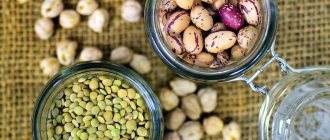For the successful completion of biochemical processes, the body needs not only proteins, fats, carbohydrates, but also small doses of catalysts, i.e. substances that will control metabolic processes in the body. In 1880 N.I. Lunin discovered that human food should contain other components essential for nutrition that are present in food in small quantities - these are vitamins, i.e. "amines of life." Vitamins are not synthesized in the human body or are synthesized in small quantities, so they must be supplied to the body through food. Consider vitamin A.
Vitamins are divided into two large groups according to their solubility in water or fat: water-soluble and fat-soluble vitamins. Water-soluble vitamins participate in the structure and function of body enzymes, fat-soluble vitamins in the structure of cell membranes (shells), ensuring their optimal functional state. Fat-soluble vitamins: A, D, E, K.
VITAMIN A (retinol ) - vitamin of growth, preservation of vision, youth and beauty. It was discovered in 1920, isolated from carrots (Carotte - carrots). The carotenoid is an orange-red pigment that, when entering the body, turns into vitamin A. The precursor of vitamin A is beta-carotene, which turns into retinol.
Which foods contain the most vitamin A?
foods high in vitamin A
In most foods, vitamin A is contained in the form of inactive compounds, which, after entering the body, begin to activate beneficial properties. Such provitamins include carotenoids, among which beta-carotene is the richest in vitamin. A distinctive feature of carotenoids is the red, orange or yellow color of plant foods. It is thanks to color that you can recognize products that contain the composition of substances required for the human body.
As a rule, in the summer, getting enough vitamin into your diet comes from a balanced diet of plant sources. In winter, the required “dosage” is obtained thanks to animal products. It is during the cold period that hypovitaminosis of the human body is often observed.
Animal products with vitamin A
Table 1 – Vitamin content (mcg) per 100 g of product and % coverage of the daily value
| Food – 100 gr | Vitamin A content, mcg | % of daily value (800-1000 mcg) |
| Cow's milk 35% fat | 35 mcg | 4% |
| Goat milk | 74 mcg | 9% |
| Cream 30% fat | 339 mcg | 42% |
| Cream 40% fat | 433 mcg | 54% |
| Low-fat cottage cheese | 2 mcg | 0,5% |
| Butter | 653 mcg | 81% |
| Melted butter | 883 mcg | 110% |
| Egg | 272 mcg | 34% |
| Duck egg | 740 mcg | 92% |
| Goose egg | 667 mcg | 83% |
| Cheeses: | ||
| Appenzeller | 397 mcg | 49% |
| Gouda 45% fat | 260 | 32% |
| Harzer | 282 mcg | 35% |
| Gorgonzola | 257 | 32% |
| Camembert 45% fat | 362 mcg | 45% |
| Limburger 40% fat | 380 | 47% |
| Parmesan 45% fat | 340 mcg | 42% |
| Processed cheese 45% fat | 300 mcg | 37% |
| Romadour fatty | 397 mcg | 49% |
| Roquefort | 310 mcg | 39% |
| Cream cheese 60% fat | 325 mcg | 41% |
| Fish: | ||
| Mackerel | 100 mcg | 12% |
| Acne | 980 mcg | 122% |
| Trout | 32 mcg | 4% |
| Carp | 44 mcg | 6% |
| Salmon | 41 mcg | 5% |
| Oysters | 93 mcg | 11% |
| Mussels | 54 mcg | 7% |
| Black caviar | 561 mcg | 70% |
| Meat: | ||
| Duck | 47 mcg | 6% |
| Goose | 65 mcg | 8% |
| Chicken | 39 mcg | 4% |
| Turkey | 13 mcg | 1,5% |
| Beef fillet | 19 mcg | 2% |
| Pork fillet | 325 mcg | 41% |
| Lamb liver | 9500 mcg | 1187% |
| Beef liver | 21900 mcg | 2737% |
| Pork liver | 39100 mcg | 4887% |
| Chicken liver | 12800 mcg | 1600% |
| Liver (turkey) | 8000 mcg | 895% |
| Cod liver oil | 30,000 mcg | 3333% |
Plant-based foods with vitamin A
Table 2 – Vitamin content (mcg) per 100 g of product and % coverage of the daily value
| Food – 100 gr | Vitamin A content, mcg | % of daily value (800-1000 mcg) |
| Sweet red pepper | 2100 mcg | 230% |
| Sweet potato | 1000 mcg | 110% |
| Carrot | 830 mcg | 93% |
| Broccoli | 800 mcg | 90% |
| Green salad | 550 mcg | 63% |
| Spinach | 470 mcg | 52% |
| Pumpkin | 430 mcg | 43% |
| Melon | 170 mcg | 20% |
| Apricot | 100 mcg | 16% |
| Tomatoes | 40 mcg | 5% |
| Polka dots | 38 mcg | 4% |
| Green pepper | 18 mcg | 2% |
Important! Pregnancy is no exception for the daily intake of vitamin A. Therefore, there is no need to increase the amount of foods containing it. Pregnancy vitamins contain a sufficient amount of beneficial components required for normal fetal development.
Is there retinol in oils?
Almost all vegetable oils lack vitamin A, with the exception of a couple of types (see Table 8). Retinol is present in animal fats.
Table 8. Which oil products contain retinol.
| Name | Quantity (per 100 ml), mcg |
| Ghee | 667 |
| Palm, sea buckthorn | 32000 |
| Unsalted butter | 653 |
| Creamy | 450 |
Many people have heard that flaxseed oil contains vitamins such as A and E. The presence of tocopherol in the ester is observed, but in fact there is no retinol. The element is also absent in other common extracts - therefore, their quantitative determination in oils of plant origin is impossible.
But the product helps vitamin A to be better absorbed. In hot-cooked foods, use olive and sunflower extract. Use other oils raw.
Important! Dry skin? Are your hair and nails growing poorly? These are sure signs of carotenoid deficiency.
The benefits of vitamin A for the human body
By adhering to the daily intake of nutrients in the diet, a beneficial effect on the human body will be observed. Namely:
- helps improve vision, normalize the condition of the cornea and tear fluid;
- takes an active part in skin regeneration, slows down the aging process;
- normalizes the stable functioning of the liver, increases its efficiency;
- Boosts immunity and protects against infectious diseases.
What if it's not enough?
Vitamin A deficiency disrupts the functioning of almost all body systems, and primarily affects appearance
.
The skin becomes drier and begins to peel, wrinkles appear on the face and hands, and dandruff appears in the hair. But the most well-known symptom of retinol deficiency is “ night blindness
,” that is, decreased vision in twilight or low-light conditions.
This condition is especially dangerous for those who have to spend a lot of time driving. Retinol deficiency also causes other vision-related symptoms. Due to deterioration in the formation of tear fluid, a feeling of “sand” appears in the eyes, redness and itching of the eyelids. This is the so-called dry eye syndrome. Men may notice a lack of this vitamin in the form of weakened erections
and premature ejaculation.
Frequent respiratory diseases
and serious decrease in working capacity are also signs of vitamin A deficiency.
Signs of Vitamin A Deficiency
If there is a lack of vitamin A in the body, so-called “night blindness” can occur. But, today, such a phenomenon is extremely rare, since a critical amount of retinol is needed. As a rule, this happens with completely unsatisfactory nutrition, almost hunger.
The first signs that the human body does not receive the required amount of vitamin (hypovitaminosis):
- the appearance of wrinkles at an early age, dry skin, partial peeling;
- decreased vision, drying out of the mucous membrane, deterioration in the quality of vision in the dark;
- frequent cases of infectious diseases;
- weakened immunity.
In cosmetology
Cosmetologists say: retinol is the gold standard in skin care. This is practically a magician who solves all problems (from acne to wrinkles). The positive effect is observed in the following:
- increased elastin production;
- stimulating the formation of new blood vessels;
- decreased activity of the sebaceous glands;
- reduction of sebum secretions;
- provoking the exfoliation of dead cells (a means of preventing clogging of pores).
Signs of excess
Although there are few cases where vitamin A is absorbed in greater quantities than necessary, they still exist. Hypervitaminosis was previously observed in residents of the North who ate bear meat every day. The liver of these animals contains excessive amounts of vitamin A.
Important! With an excess of vitamin, problems are observed not only with the digestive system, but also with disorders of the nervous system.
Today, cases of consuming large amounts of vitamin A are possible when a person drinks carrot juice every day in excess of the required norm, wanting to saturate the body with useful substances. After this, carotene accumulates in the dermis, resulting in a yellowish color of the skin. The shade becomes especially noticeable on the palms and heels. If you follow the norms of consuming foods containing vitamin A in your diet, skin color will be restored within a few weeks.
How many do you need?
The daily dose
of vitamin A for men is about 1000 mcg, for women – 800 mcg, and for newborns – about 400 mcg.
Retinol can accumulate in the body if it enters it in excess. True, the body receives less vitamin A from carotenoids supplied with plant foods than from animal products. One microgram of retinol comes from 6 mcg of beta-carotene or 12 mcg of other carotenoids, such as lutein, lycopene or zeaxanthin. The dose of vitamin A entering the body must be carefully monitored during pregnancy, since its excess can lead to impaired fetal development
and the appearance of various birth defects in the child. Therefore, taking multivitamin complexes while expecting a baby should be under the strict supervision of the attending physician.
Causes of vitamin A deficiency in the body
If there is a deficiency of vitamin A in the body of a healthy person, several factors may affect this:
- Low quality of consumed products. This is often observed in the presence of nitrates in food products (tomatoes, carrots, herbs, etc.). Remember, the better, more natural and fresh the products, the more required nutrients they contain.
- Disruption of the digestive system. Such disorders include gastritis, pancreatitis, colitis and cholelithiasis. In this case, you will need to increase the dose of the vitamin, after consulting with your doctor, who will be able to create an individual diet.
- Improperly balanced diet. Frequent consumption of fast foods, semi-finished products, fried foods, not fresh foods, and weekly meals. Remember that foods and foods that are prepared immediately before consumption are better digested, and not those that sit in the refrigerator for several days and are reheated. All this will contribute to a decrease in the amount of vitamin A and its ineffectiveness for the body.
Beneficial features
Each vitamin has its own function in the body. Retinol has several of them.
- It has a positive effect on the functioning of the visual organs. This is a means of preventing senile blindness.
- Vitamin A is essential for maintaining the integrity and function of skin cells, as well as the respiratory and digestive systems.
- Retinol plays an important role in the development of lymphocytes (white blood cells). They are key agents in the immune system response.
- Prescribed for pregnant women: participates in the growth of limbs, the formation of the baby’s heart, eyes and ears. Also responsible for growth hormone: a deficiency can provoke a birth defect.
- Considered a strong antioxidant. It has the ability to neutralize free radicals that lead to the development of chronic diseases (for example, diabetes).
- Retinol is the key to healthy bones. With enough of it, the risk of fractures is reduced by 6%.
Daily norm
Each of us needs sufficient amounts of retinol. The table shows the daily requirement for the vitamin for different age groups.
| Category | Acceptable daily allowance | Maximum permissible dose |
| Children under 1 year | 400 | 600 |
| Children from 1 to 3 years old | 300 | 900 |
| Children from 4 to 8 years old | 400 | 900 |
| Children from 9 to 13 years old | 600 | 1700 |
| Men over 14 years old | 900 | 2800-3000 |
| Women over 14 years old | 700 | 2800 |
| Pregnant | 770 | 1300 |
| Nursing mothers | 1300 | 3000 |
| Athletes over 18 years old | 1500 | 3000 |
Bottles with dietary supplements usually describe the method of administration and the content of the active substance in 1 capsule or measuring spoon. Based on the data in the table, it will not be difficult to calculate your vitamin A requirement.
Please note that the need for vitamins among athletes is much higher than among people who are far from sports. For those who regularly subject their body to intense stress, it is important to remember that the daily intake of retinol to maintain the health of the musculoskeletal system should be at least 1.5 mg, but not exceed 3 mg to avoid overdose (this is also reflected in the table above) .
History of the vitamin
Vitamin A got its name due to the fact that it was discovered earlier than others and became the owner of the first letter of the Latin alphabet in the designation. In 1913, two independent groups of scientists in laboratory conditions found that in addition to a diet balanced with carbohydrates and proteins, the body requires certain additional components, without which the integrity of the skin is damaged, vision decreases and the functioning of all internal organs is destabilized.
Two main groups of elements were identified. The first was called group A. It included synthesized retinol, tocopherol and calciferol. The second group, accordingly, was named B. It included many substances with similar properties. Subsequently, this group was periodically supplemented, and some of its elements, after a long study, were completely removed from it. This is why there is vitamin B12, but not B11.
Long-term work to identify the beneficial properties of retinol was awarded the Nobel Prize twice:
- for the description of the complete chemical formula of retinol by Paul Karrer in 1937;
- for studying the beneficial effects of retinol on visual restoration by George Wald in 1967.
Vitamin A goes by many names. The most famous is retinol. You can also find the following: dehydroretinol, antixerophthalmic or anti-infective vitamin.
What to eat?
The highest levels of retinol are found in fish oil and beef liver. There is enough of it in dairy products - milk, cream, butter and cheeses, as well as chicken eggs.
Almost all bright yellow and red vegetables and fruits, as well as dark green leafy crops such as spinach, broccoli or green onions, are rich in carotenoids. There are carotenoids in legumes. Together with fats, beta-carotene is absorbed 30 percent better. But only if it enters the body on an empty stomach, so this is not a reason to consume excess fat. For normal absorption of beta-carotene, the fats that a person receives during the day from food are sufficient.











